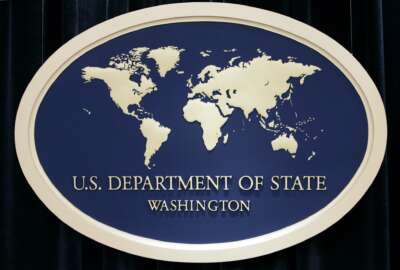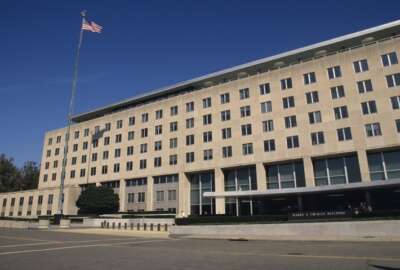

State Department Chief Diversity and Inclusion Officer Gina Abercrombie-Winstanley says her top priority is “restoring trust” in a workforce that has seen ...
Best listening experience is on Chrome, Firefox or Safari. Subscribe to Federal Drive’s daily audio interviews on Apple Podcasts or PodcastOne.
The State Department’s first chief diversity and inclusion officer is picking up where the Trump administration left off drafting a multi-year diversity and inclusion strategy, but is also now sitting on the committee that reviews candidates to serve as chiefs of mission and as deputy assistant secretaries.
The department earlier this month named Ambassador Gina Abercrombie-Winstanley, a career employee with more than 30 years of experience, to serve as its first CDIO.
It’s a position Secretary of State Antony Blinken told members of the Senate Foreign Relations Committee he would make a top priority, and would elevate its authority, during his confirmation hearing.
Abercrombie-Winstanley testified before the House Foreign Affairs Committee last year in a hearing focused on the department’s longstanding diversity challenges. During this year, she recalled training for the State Department’s Board of Examiners, which oversees testing to join the Foreign Service, and hearing that “African-Americans have cognitive difficulties with large amounts of reading material.”
Abercrombie-Winstanley also served on a Truman Center task force this year focused on recommendations to elevate the CDIO job she now holds.
While Abercrombie-Winstanley outlined several goals to meet during her tenure, she said her top priority is “restoring trust” in a workforce that has seen diversity and inclusion work fall by the wayside across multiple administrations.
“Our organization, our leadership has said for the past 30-plus years, ‘We’re not where we want to be, but we’re making progress,’ or ‘We want the Foreign Service or the Department of State to look like America.’ We’ve been saying it a long time, and it is not true. So we’ve got to restore trust, and that means making visible progress and making sure that people understand even we work toward this progress that we are seriously working toward that progress,” Abercrombie-Winstanley said.
The department had chief diversity officers before the Biden administration, but Abercrombie-Winstanley said Blinken has “empowered” the role to focus exclusively on diversity and inclusion work. Previous chief diversity officers served in a dual-hatted job as the head of the department’s Equal Employment Opportunity Office.
“Two huge jobs, and two very different jobs,” Abercrombie-Winstanley said in an interview. “There is a bright red line between working on issues of inclusion and ensuring that people follow the law, and that’s what EEOC is about. The challenges are sufficient there that, honestly speaking, I would posit — and I believe the former incumbents would say — that there was not the resources and time to fully inhabit the CDO role. In fact, I believe very little got done on the inclusion part from that person, and based completely on the fact that they had a huge job as head of the EEO office,” Abercrombie-Winstanley said.
The department across multiple administrations has recognized barriers that kept a diverse pool of talent from serving in leadership positions. The Government Accountability Office last year found racial and ethnic minorities within the department’s civil service were 29% less likely to receive a promotion than their white peers with similar qualifications.
The report also found a lower proportion of women and ethnic minorities in the department’s leadership positions.
While the latest GAO report spurred multiple congressional hearings and task force reports, the watchdog office reached some of the same conclusions over the past 30 years. A GAO report from 1989 outlines many of the same conclusions as the 2020 report.
Secretary of State Antony Blinken, in announcing Abercrombie-Winstanley as the CDIO, said the department has yet to move the needle on problems it has known about for decades.
“There’s been a lot of attention focused on what’s happened with diversity and inclusion in the last few years, including the alarming lack of diversity at the highest levels of the State Department, but the truth is this problem is as old as the department itself,” Blinken said. “It’s systemic, it goes deeper than any one institution or any one administration, and it’s perpetuated by policies, practices and people to this day.”
Abercrombie-Winstanley recalled hearing messages promoting diversity from leadership when she joined the department in 1985, but was the only woman of color serving at the U.S. Embassy in Iraq. Nearly 30 years later, she was still the only woman of color in meetings when serving as U.S. Ambassador to Malta.
“That experience is repeated around the world and throughout offices in the Department of State, which is that you are the one, or one of the very few, which is challenging. Don’t take me wrong, we’re bold people, we joined the Department of State — we’re smart, we’re told it before we come. It is incumbent on us to inhabit our space. Nonetheless, you can feel intimidated walking in like that, and it does mean that for some people, you may hesitate to give your full contributions, which means we’re missing out on something. We’re missing out on creativity, or background or experience that should be contributing to solutions,” Abercrombie-Winstanley said.
State Department officials have pointed to diversifying its higher ranks as a particularly thorny problem for the Foreign Service, given its formal “up or out” system that’s akin to military service. But Abercrombie-Winstanley said the department hasn’t moved the needle on this front across multiple generations of Foreign Service officers.
“I was part of a pipeline, and so the number of people that had been coming through should have fixed the problem, and so then we get to promotion and retention. We have to look at where those chokepoints are, as people are moving up the ranks. We’ve begun to do that already, we’ve identified choke points, but now we have to identify where are the barriers. At that chokepoint, what’s happening? Is it that there is a lack of preparation for something? Is there a lack of knowledge about how to navigate that chokepoint, if it’s a promotion from one level to the next? What are the things the officer has to do really make themselves competitive for that next promotion?” Abercrombie-Winstanley said.
Those chokepoints, she added, may have less to do with the talent pool and more with management making the selections.
“When you recognize that those who are making the decisions are largely from one group, then what they bring to the table may not be entirely compatible in recognizing the range of excellence that more diverse candidates are bringing, and they get stopped that way,” Abercrombie-Winstanley said.
As part of the department’s elevation of her job, Abercrombie-Winstanley said she now sits on the “D committee” of senior officials that select officers in the Foreign Service.
“Everyone’s got to meet the requirements, if they’re looking for a senior position — chief of mission, deputy chief of mission, etc. They have to have shown that they can do the work, they are a strong leader, manager and carer of people, our most important resource. That cherry on top is we’re looking for people who bring all of that and are going to be bringing different perspectives and backgrounds to it – to ensure we look like America,” Abercrombie-Winstanley said.
Meanwhile, Abercrombie-Winstanley said the department is looking at identifying civil service employees who might be interested in Foreign Service careers.
“They already have State Department knowledge. They already have security clearances. They already have regional expertise that can be plugged in, not starting from the bottom,” Abercrombie-Winstanley said.
A few weeks into her tenure, Abercrombie-Winstanley selected a deputy chief diversity and inclusion officer from the department’s career workforce. She and her deputy are meeting with the department’s other bureaus to learn more about their work promoting diversity.
“People are reaching out to me around the word from bureaus, and so there are a lot of good things that are happening out there,” Abercrombie-Winstanley said, adding that her office will share some of the best practices she’s learned from the field.
These best practices, she said, range from making bureaus have “difficult conversations” about diversity and representation, to making sure a diverse pool of talent has equal access to sought-after assignments at the department.
“Those good assignments get them promoted, and it’s those promotions that get people to stay – to not lose hope, but to stay,” Abercrombie-Winstanley said.
Her office is also resuming work on the draft diversity and inclusion plan started under the Trump administration.
The department’s former undersecretary for management Brian Bulatao led a task force to craft a strategy that would guide the department through 2024, but that work stalled after former President Donald Trump ordered a government review of diversity and inclusion work.
“The work was started under previous administrations, which is excellent, and now we’re going to bring it home,” she said.
Before her office sets diversity and inclusion goals for the department, Abercrombie-Winstanley said she’s focused on pulling together workforce data that’s scattered across the department and bringing greater transparency to the workforce’s demographics.
“Before we set benchmarks, we have to know where we are,” she said. “We’ve got to find that data, which lives in the department in several different places. We’ve got to pull it together and we have to drill down and really understand where we are – not only bureau-wide, but also office-wide.
However, she said the department has an obligation to protect employees’ privacy and ultimately relies on employees to self-identify their gender and ethnicity in surveys. In other words, better data relies on better participation.
“I haven’t filled out every survey that’s come out to identify me as an African American woman, because I wasn’t sure or I didn’t think it would make a difference on what’s going to happen,” Abercrombie-Winstanley said.
Copyright © 2024 Federal News Network. All rights reserved. This website is not intended for users located within the European Economic Area.
Jory Heckman is a reporter at Federal News Network covering U.S. Postal Service, IRS, big data and technology issues.
Follow @jheckmanWFED


